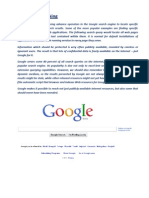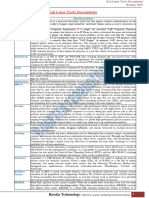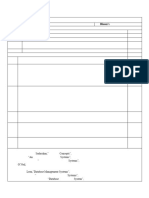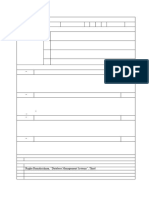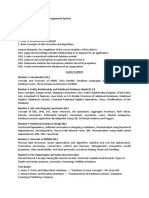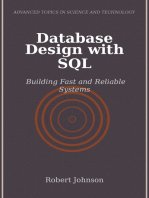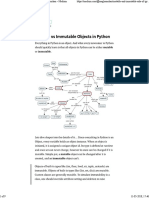Int306:Database Management Systems: Course Outcomes
Uploaded by
Madesh TurakaInt306:Database Management Systems: Course Outcomes
Uploaded by
Madesh TurakaINT306:DATABASE MANAGEMENT SYSTEMS
L:0 T:0 P:5 Credits:3
Course Outcomes: Through this course students should be able to
CO1 :: develop skills and understanding in the database design and make use of database
management systems for applications
CO2 :: develop understanding about relational algebra, relational model and SQL for
implementing and maintaining databases
CO3 :: develop understanding about the different issues involved in the design and
implementation of a database system
CO4 :: develop skills and understanding about the real time transaction management systems
and the concurrency control techniques
CO5 :: compose programming constructs such as functions, stored procedures and triggers that
can be shared by multiple forms, reports and data management applications
List of Practicals / Experiments:
Introduction to Databases
• purpose of database systems, components of dbms, applications of dbms
• three tier dbms architecture
• data independence, database schema, instance
• data modeling, entity relationship model, relational model
Relational Query Languages
• relational algebra
• introduction to data definition language, data manipulation
• data control and transaction control language
• integrity constraints
• database keys
• sql basic operations
• aggregate functions
• sql joins
• set operators, views
• subqueries
Relational Database Design
• data integrity rules, functional dependency
• need of normalization, first normal form, second normal form
• third normal form, boyce codd normal form
• multivalued dependencies, fourth normal form
• join dependencies, fifth normal form and pitfalls in relational database design
Database Transaction Processing
• transaction system concepts, desirable properties of transactions
• schedules, serializability of schedules
• concurrency control
• recoverability
Programming Constructs in Databases
• flow control statements
• functions, stored procedures
Session 2019-20 Page:1/2
• cursors
• triggers
• exception handling
File Organization and Trends in Databases
• file organizations and its types
• indexing, types of indexing
• hashing, hashing techniques
• introduction to big data, nosql systems
Text Books:
1. DATABASE SYSTEM CONCEPTS by HENRY F. KORTH, ABRAHAM SILBERSCHATZ, S.
SUDARSHAN, MCGRAW HILL EDUCATION
References:
1. DATABASE SYSTEMS: MODELS, LANGUAGES, DESIGN AND APPLICATION PROGRAMMING
by RAMEZ ELMASRI, SHAMKANT B. NAVATHE, PEARSON
2. AN INTRODUCTION TO DATABASE SYSTEMS by C. J. DATE, S. SWAMYNATHAN, A.
KANNAN, PEARSON
3. SQL, PL/SQL: THE PROGRAMMING LANGUAGE OF ORACLE by IVAN BAYROSS, BPB
PUBLICATIONS
4. SIMPLIFIED APPROACH TO DBMS by PRATEEK BHATIA AND GURVINDER SINGH, KALYANI
PUBLISHERS
Session 2019-20 Page:2/2
You might also like
- The Organization of Information 4th Edition (2017, Libraries Unlimited)97% (34)The Organization of Information 4th Edition (2017, Libraries Unlimited)483 pages
- Dangerous Google - Searching For Secrets PDF88% (26)Dangerous Google - Searching For Secrets PDF12 pages
- Voyager 7S Data Dictionary - Through Update DB 5854 - 06061967% (3)Voyager 7S Data Dictionary - Through Update DB 5854 - 0606193,877 pages
- Understanding Database Types - by Alex XuNo ratings yetUnderstanding Database Types - by Alex Xu13 pages
- Policy Document Ucc Redemption Understanding The Process Further80% (20)Policy Document Ucc Redemption Understanding The Process Further37 pages
- Dark Web Market Price Index Hacking Tools July 2018 Top10VPN291% (11)Dark Web Market Price Index Hacking Tools July 2018 Top10VPN27 pages
- Color-Coded Genealogy Research Filing SystemNo ratings yetColor-Coded Genealogy Research Filing System15 pages
- CS-2004 Database Management Systems Cr-4: Course Outcome: at The End of The Course, The Students Will Be Able ToNo ratings yetCS-2004 Database Management Systems Cr-4: Course Outcome: at The End of The Course, The Students Will Be Able To2 pages
- Lecture 1.1 Overview of Databases and Lecture 1.2 DBMSNo ratings yetLecture 1.1 Overview of Databases and Lecture 1.2 DBMS21 pages
- Apex Institute of Technology: Department of Computer Science & EngineeringNo ratings yetApex Institute of Technology: Department of Computer Science & Engineering21 pages
- III/IV B.Tech First Semester PVP14 Database Management Systems (Cs5T1) Department of Computer Science and Engineering Micro SyllabusNo ratings yetIII/IV B.Tech First Semester PVP14 Database Management Systems (Cs5T1) Department of Computer Science and Engineering Micro Syllabus2 pages
- Dbms r16 Syllabus of Jntuk and Its Structure0% (1)Dbms r16 Syllabus of Jntuk and Its Structure4 pages
- Ad3391 Database Design and Management L T P CNo ratings yetAd3391 Database Design and Management L T P C2 pages
- BTech CSE Syllabus_Batch-2023-2027 22 Aug 2023 (1) (1)-52-53No ratings yetBTech CSE Syllabus_Batch-2023-2027 22 Aug 2023 (1) (1)-52-532 pages
- Database Management Systems: Course Description and ObjectivesNo ratings yetDatabase Management Systems: Course Description and Objectives3 pages
- CSC2203 Database Systems: Course Information SheetNo ratings yetCSC2203 Database Systems: Course Information Sheet3 pages
- Syllabus For Data Analysis and AlgorithmsNo ratings yetSyllabus For Data Analysis and Algorithms1 page
- HTTP App - Utu.ac - in Utuexmanagement Exammsters Syllabus CE4012 Database Management System - Docx - 2No ratings yetHTTP App - Utu.ac - in Utuexmanagement Exammsters Syllabus CE4012 Database Management System - Docx - 26 pages
- Database Management System: Biyani's Think TankNo ratings yetDatabase Management System: Biyani's Think Tank204 pages
- Dcap204 Managing Database Dcap402 Database Management Systems PDFNo ratings yetDcap204 Managing Database Dcap402 Database Management Systems PDF265 pages
- Database Design with SQL: Building Fast and Reliable SystemsFrom EverandDatabase Design with SQL: Building Fast and Reliable SystemsNo ratings yet
- Open Source Intelligence (Osint) Reference Sheet0% (1)Open Source Intelligence (Osint) Reference Sheet23 pages
- Other Link Classified - How To Find The Book I WantNo ratings yetOther Link Classified - How To Find The Book I Want453 pages
- Avaya VoIP Monitoring Manager ReferenceNo ratings yetAvaya VoIP Monitoring Manager Reference114 pages
- GetLogicalDriveStringsA Function (Winbase.h) - Win32 Apps - Microsoft LearnNo ratings yetGetLogicalDriveStringsA Function (Winbase.h) - Win32 Apps - Microsoft Learn3 pages
- Froid Open Instrument Server Functional Spec 091No ratings yetFroid Open Instrument Server Functional Spec 0919 pages
- ZyLAB Web Client For System Administrators ManualNo ratings yetZyLAB Web Client For System Administrators Manual52 pages
- Lab 05 Stack Implementation With ApplicationsNo ratings yetLab 05 Stack Implementation With Applications2 pages
- Granting Sharepoint Administrator Role in PowershellNo ratings yetGranting Sharepoint Administrator Role in Powershell9 pages
- Naing - Min - Khant - E6I1201 - Data - Com Task-2No ratings yetNaing - Min - Khant - E6I1201 - Data - Com Task-25 pages
- C - C++ - Ebooks Collection Sha HashsumNo ratings yetC - C++ - Ebooks Collection Sha Hashsum12 pages
- Chapter Summary: How Sets Work-Practical ConsequencesNo ratings yetChapter Summary: How Sets Work-Practical Consequences2 pages












